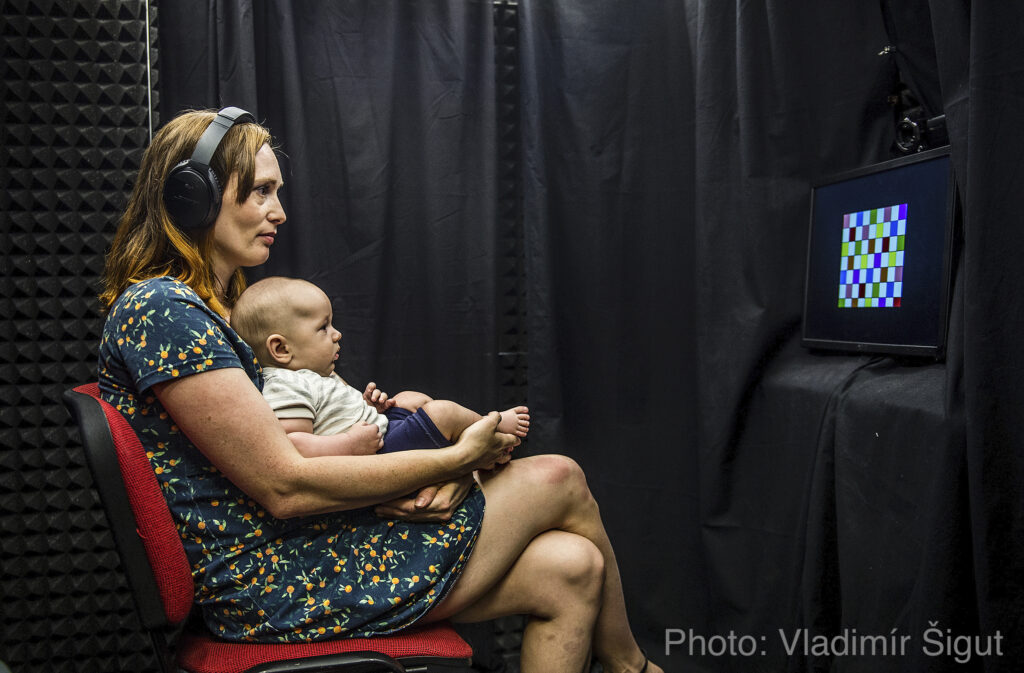Speech production across situations and dialects
Varieties and dialects of Czech
We investigate how the sound form (speech) of Czech changes depending on region, education, age and social class.
We have previously published a description of the vocals of spoken Czech in Central Bohemia. We recommend a recent article on the phonetic form of the Moravian-Silesian variety of Czech, Context-induced shift in Silesian Czech speakers, by our colleagues Šárka Šimáčková and Václav Jonáš Podlipský (2023). We reported on how education and orthography change the sound form of the Silesian regional variety in adolescents in our poster Conflicting effects of orthography on the de-regionalization of adolescent speech (Šimáčková et al., 2023).
Early childhood
In the first experiment, we investigate whether infants learn speech sounds more effectively from a native-accented talker than from a

non-native one. Babies between 4 and 10 months of age are played utterances spoken by talkers with typical, standard Czech accent and by talkers with atypical, foreignized accent. Preliminary data (reported in this poster) suggest that the youngest, 4-month old, babies prefer listening to the typical over the foreignized accent while older infants do not seem to have such preferences. The four-month olds are now being tested on whether they not only preferentially listen to native-accented talkers, but also if they more efficiently learn new speech sounds from them.
For adults, we also tested whether dialect (specifically, word stress, which differs between the Central Bohemian and Moravian-Silesian dialects of Czech) plays a role in how they recognize words in the speech stream (Native variety influence on speech segmentation in a novel language, Podlipský et al.)

This experiment is done jointly with Václav Jonáš Podlipský and Šárka Šimáčková (Palacký University).
- poster Young and older infants distinguish between native and foreign-accented rhythm but have different preferences (Podlipský et al.)
- poster Prosody driven word segmentation children acquiring Czech k projektu Learning to recognize words: a cross-dialectal perspective (Chládková et al.)
- Native variety influence on speech segmentation in a novel language (Podlipský et al.)
Preschool age
In the second experiment, we test whether pre-school children have preferences for peers speaking their local over a regional dialect, and whether any such preference is modulated by the child’s own dialectal experience. Infants, older children and adults are known to favor native-accented over foreign-accented speakers: people prefer playing with, or trust more, a person who has a native accent than with someone who has a foreign accent.
In this project we investigate whether similar preferences exist in children’s perception of regional accents of their language. Pre-school children from two regions, central Bohemia and Silesia, where distinct varieties of Czech are spoken, were tested on their social peer preferences. Children viewed photos of other kids and heard utterances spoken in their own and in the other dialect. They were asked to indicate which of two simultaneously presented kids they would like to play with. The project shows whether regional accent has similar effects as those previously reported for foreign accents, and if that effect is modulated by a child’s (multi-)dialectal exposure.
Currently, the data collection is over. Our research shows that in addition to the region where a child grows up, it also depends on their age. The results show that younger children aged 5-6 were more likely to choose friends who spoke their native dialect. However, we did not observe this trend for older children.
This experiment was done as a student internship project within the Open Science programme and the results were presented in the article in Československá psychologie.
We followed up by designing the same experiment in which we investigated the influence of foreign (L2) accent. As in the previous experiment, children listened to recordings of peers who differed in accent. They then chose with whom they would prefer to play. Two groups of preschool children from Prague participated: monolingual and bilingual. We investigated whether bilingualism, i.e., the children’s different language experience, influenced the preferences. Both groups showed a preference for peers with native, standard accents, but this preference was on average 11% lower in the bilingual group. We report the results in an article in the Journal of Multilingual and Multicultural Development.
- Kikoťová, N., Nudga, N., Šimsová, J., Maršíková, Z. & Chládková, K. (2023). Jazykově podmíněné sociální preference dětí: vliv regionálního dialektu na výběr kamaráda [Language-based social preferences: The effect of dialect on friendship choices]. Československá Psychologie, 67(3-4), 166-178.
- Jarůšková, L. & Chládková, K. (2023). Preference for native-accented peers in monolingual and bilingual children acquiring Czech. Journal of Multilingual and Multicultural Development.
We are also currently designing and testing experiments on language-based social preferences in toddlerhood and school age.